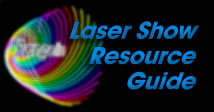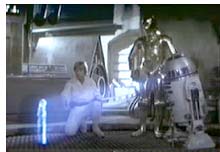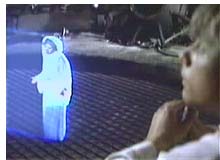|



|
 |

|
Making 3D, floating images
|
| |
|
|

|
|
 One of the most frequent questions
we get at Pangolin is: "How do I make 3D images float in
mid-air?" This question probably comes because many people have seen
special effects such as the "Princess Leia" scene from Star Wars. One of the most frequent questions
we get at Pangolin is: "How do I make 3D images float in
mid-air?" This question probably comes because many people have seen
special effects such as the "Princess Leia" scene from Star Wars.
Unfortunately, there is no such
thing as a floating-in-midair 3D holographic freespace projection. There
are various ways of approximating such a projection; these are discussed
below.
|
|
Holograms, of course, do show three-dimensional images. However, you
normally have to look at or through a piece of glass (or film) to see the
image. If there is any "mid-air" effect, it is because the
holographic image appears slightly in front or behind the glass.
The largest hologram is about 1
meter square. The projected image appears to come out about 1 meter in
front of the glass. Only two or three people can easily see the image at
one time, so it is best suited for a museum-type application.
|
|
It is possible to project the image which is stored
within the holographic glass's film emulsion. This is done by taking a laser beam and projecting it
through the glass. The particular view stored at that location can be
projected onto a screen or similar surface. As the laser is moved, the
image changes since different views are being shown. (An analogy is if you
look out a window, through a hole in a piece of cardboard. You can move
the cardboard around and see different views or perspectives of the same
light coming through the window.)
A projected holographic image is exactly the same as projecting a
slide or a movie. The projected image is shown in two dimensions on a
screen or flat surface. As with a slide or movie, you can project into a
fog, cloud or other volume, but as with a slide or movie, you will get a
shaft of light.
True volumetric 3D
|
|
 There are a few methods of making a true three-dimensional image appear
in a volume of space. These would be the closest to the "Princess
Leia" type of image. But all current methods have severe limitations. There are a few methods of making a true three-dimensional image appear
in a volume of space. These would be the closest to the "Princess
Leia" type of image. But all current methods have severe limitations.
NEOS Technology has one of the
largest volumes; a cylinder approximately one meter high by 1/2 meter
diameter. Inside the cylinder, a helix spins at high speed. The image is
projected onto the helix. At this time, the images are simple CAD-like
drawings (for air traffic control or submarine warfare).
Another method uses two lasers
which intersect inside a cube of a special material. The material glows at
the intersection. (Pangolin's software is currently used to create 3D
images in the volume.) The largest cube is about 1.5 cm on each side. You
can see this at the website for 3D
Technology Laboratories.
There is no volumetric
technology mature enough to do a full-color, reasonable size
representation of a human being such as Princess Leia, projected in
freespace (as opposed to looking into a TV-like box).
|
|
For projecting large 3D images to a crowd, the best current technology
is stereoscopic 3D. This is what is used at theme parks such as Walt
Disney World ("Captain EO", "Honey, I Shrunk the
Audience", "Muppet Movie") and Universal Studios
("Terminator 3D"). It is also used at IMAX Solido movie
theatres.
All stereoscopic 3D techniques
require the audience to wear special glasses. Each eye must see a
different view. Four common methods are:
-
Anaglyph or color (left eye red, right eye
blue or green)
-
Polarized (left eye looks through vertical
polarizing film, right eye looks through horizontal polarizing film)
-
Alternating-field (LCD "shutter"
glasses block the right eye when a left-eye frame is being displayed,
and vice versa)
-
Chromatic displacement or ChromaDepthฎ
(flat holographic "prisms" displace colors so red looks
closest and blue farthest away)
The 3D effect, if done
properly, can be quite striking. But again it is not a mid-air projection.
It looks more like viewing a theatrical stage.
There are many sources for more
information on stereoscopic 3D.
Pangolin's Lasershow Designer
2000 software can do stereoscopic 3D laser shows, should you need that
capability. The projectors are complex and require expertise in design and
operation. A good example of the results are the stunning 3D
laser-and-slide multimedia shows from our client Lightspeed
Design.
|
|
People often think that lasers can create 3D by simply projecting into
a cloud, smoke, water tank or some other semi-translucent medium.
What happens is that the beam
must travel through the medium. The result is shafts of light.
-
Projecting a circle through fog produces a cone of light. The tip of
the cone is at the projector.
-
Projecting a line produces a triangular plane of light. The tip of
the triangle is at the projector.
-
Projecting an image of a person produces a fuzzy cone with different
bright lines, corresponding to the bright areas of the image. It is
impossible to make out the image, unless you see the projection hit a
surface (such as a back wall).
While 3D volume effects such as cones and planes can be very exciting,
they also cannot produce a "Princess Leia" type of effect. For
this effect, light would somehow have to stop in mid-air, which is
impossible unless the light hits a surface.
Projection onto hidden
surfaces
|
|
One old trick in the laser field is to hang a dark or black scrim
(loosely-woven cloth) above an audience in a dark room. When the laser
hits the scrim, there will be an image appearing to hang in mid-air, since
the scrim cannot be seen.
The image itself will be flat,
just like a slide or movie image.
You can get an illusion of a 3D
object in space by projecting an animation where a 3D object, shot against
a black background, rotates or moves so you can see all sides. But this is
merely an illusion whose quality at best is pseudo-3D.
If a sequence of scrims are
hung, then there is a 3D effect of a series of floating objects. Of
course, since the same image hits all scrims, the floating objects are all
the same.
|
|
Sometimes, it is enough simply to project a laser show or movie of a 3D
object moving. If the contrast ratio is high enough, the 3D object can
appear to be floating in space.
The classic effect here is a
laser show in a planetarium. Unlike TV or film, where "black" is
really a gray rectangle, the laser has a very high contrast ratio of over
300:1. This makes the image separate from the background. If the image is
a sequence showing, for example, a 3D Space Shuttle rotating, then many
viewers will have the illusion that the Space Shuttle really is in
mid-air.
If you need to do a person's
picture, you can use Pangolin's "raster" feature. This creates a
set of lines like a coarse TV image. We can further map the person's
forehead, nose, chin, etc. into heights to create a "push-out"
3D illusion. The lines take on the contours of the face, much like one of
the toy pushpin devices.
When the raster image is
projected in darkness and made to rotate, a convincing 3D appearance is
seen.
Other techniques
|
|
At Walt Disney World's
"Haunted Mansion", there are some
elaborate 3D illusions. Many visitors think they are
holograms, but they are not.
One
illusion uses a pane of glass tilted at a 45 degree
angle. A manikin is behind the glass and another is
at the side. By varying the lighting, it is possible
to show each manikin separately, or to superimpose
both of them. A disadvantage of this is that only a
few visitors at a time can see the illusion; this is
why the ride's cars transport visitors past the
glass.
This
general class of illusions -- reflections off tilted
glass -- is known as
"Pepper's
Ghost" after a stage trick first presented in 1863.
Another
illusion seen in the "Haunted Mansion"
uses a "screen" that is a mold of a face.
When a film of a person talking is projected onto or
through the mold, it appears that there is a 3D
head.
|
This has been a quick review of 3D techniques. As you can see, it is
impossible with today's technologies to do a true 3D holographic mid-air
projection. But depending on the project, there are other 3D methods which
may meet the designer's goals.
|
|
|
|
This page last updated:
Wednesday, Januari 29, 2020
| |
|


 One of the most frequent questions
we get at Pangolin is: "How do I make 3D images float in
mid-air?" This question probably comes because many people have seen
special effects such as the "Princess Leia" scene from Star Wars.
One of the most frequent questions
we get at Pangolin is: "How do I make 3D images float in
mid-air?" This question probably comes because many people have seen
special effects such as the "Princess Leia" scene from Star Wars. There are a few methods of making a true three-dimensional image appear
in a volume of space. These would be the closest to the "Princess
Leia" type of image. But all current methods have severe limitations.
There are a few methods of making a true three-dimensional image appear
in a volume of space. These would be the closest to the "Princess
Leia" type of image. But all current methods have severe limitations.